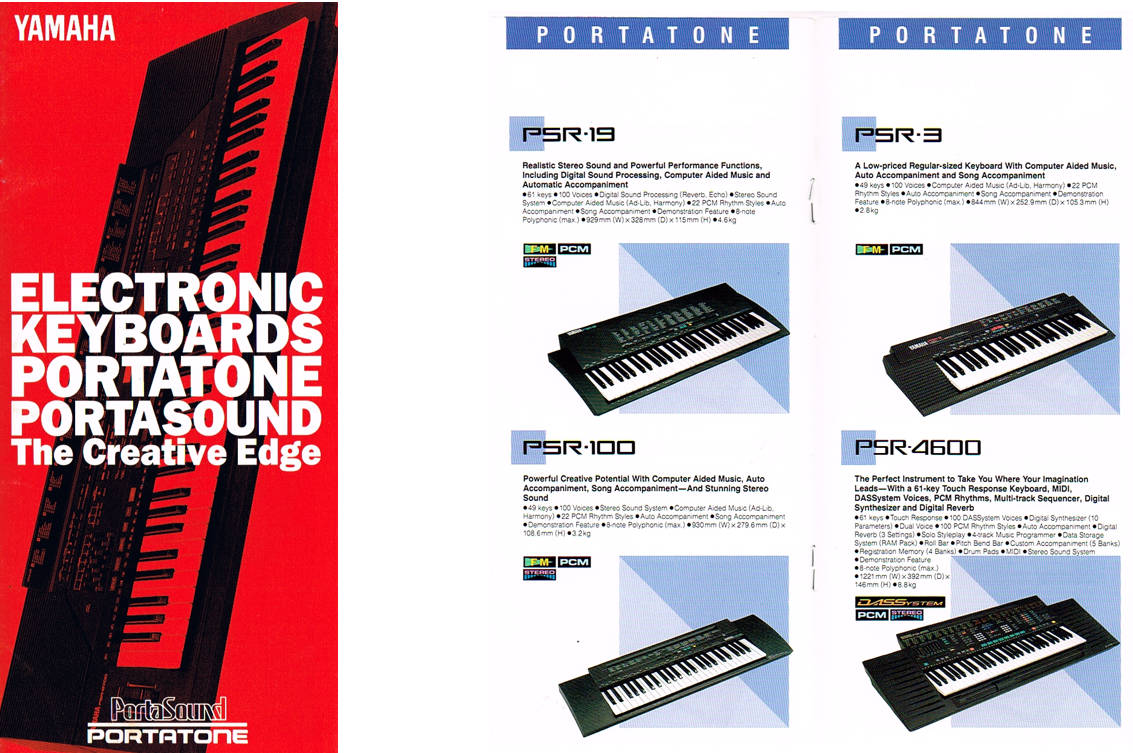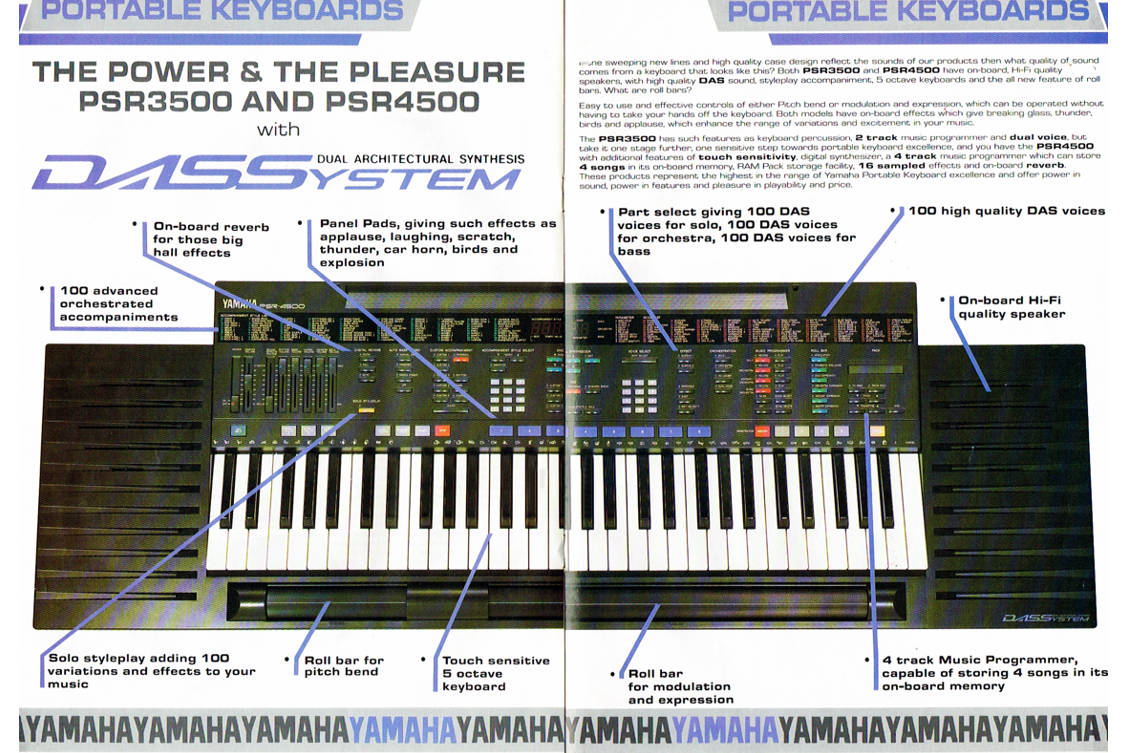WOLF retro Design Review
11th November 2019
Our review aims to deliver insight from the perspective of a designer’s mind and eyes.

Ready to take flight
Introduction
Product description
Yamaha made a big push in the late 80’s to be king of the keyboards and came out with a huge range of amateur keyboards. Their efforts paid off and by the late 80’s had stolen the show from Casio who were very dominant in the early 80’s. The PSR-4600 was at the top of their PSR range and advertised itself as being a semi-professional instrument because of its large memory of quality sounds.
Price and Availability.
Good examples exist and do show up from time to time. While designed for home use, they are well built and tend to have survived well. Be aware that while not heavy they are deceptively large at 1.2m in length, and might not be economical to post or transport. Out of the entire PSR range this is clearly the biggest, best and top of the line among Yamaha’s keyboard range. In our opinion it’s a future classic and one of the more collectible amateur instruments.
Additional information
The 4600 was actually an updated model to the 4500 which came out one year prior (1989). It is identical except for a few changes in sounds and on-board rhythms. Apart from the label stating it as the 4600 the only other cosmetic difference of note are the graphics in the bottom right corner of the right-side speaker which are in a dull gold colour.
The 4600 was not available in the USA according to our research. The top dog there was the 4500 and interestingly was labeled as the X4500.
Review

First impression/ Delight
Our first impression was that it looks rather fun and cool. Although this was a 1990 model, it really has an 80s look and feel. Lots of bright coloured buttons clutter the main panel to create a gadget filled impression.
The most obvious feature of this unit are the speakers that extend out each side like wings. From various angles it looks like it’s ready to take flight
Exterior Design Review
Further to the wing like speakers the PSR-4600 has a very unique roll bar located in front of the keyboard as its pitch bend and modulation controller. It’s a very bold design idea that we think was intended to enhance the symmetry of the unit. The functionality of this design feature is questionable and it makes the machine feel fat and bulkier than necessary.
The main control panel looks as though it can tilt adjust and would have been unique if it could really move and even close in a similar fashion to Yamaha’s PSR- 6300 (1986). A digital display panel as opposed to just LED numbers would have been nice but we can appreciate this cost saving. The band of written information makes up for the limited display but does further clutter an already very busy front panel.


impressive angles from the rear view
Craftmanship.
As with all Yamaha home keyboards at that time, there is a lot of plastic and while it’s of a high grade with texture it does not presume to compare against Yamahas professional line. Despite this it is well assembled in feels sturdy. All buttons, sliders and the roll bar feel solid and well made.
The rubber buttons are soft and encourage use like a drum machine. The unit in this review did have some ware to the lettering of a few rubber buttons despite being a well-loved machine. This suggests to us that these rubber button would not have survived well in really well used machines.
The plastic date strip across the top looks a little cheap and really defines this as an amateur home instrument.


FUNCTION- Experience.
As with all Portatone keyboards their big advantage are the built-in speakers. Take it anywhere and play was the idea. However, the speakers on the PDR-4600 are large and extend out sideways to make this instrument longer than most conventional 61 key synths at the time. It’s not very practical to transport and there are no Yamaha Hard cases for this instrument that we know of. It’s a home keyboard designed to stay home.
It is an easy instrument to navigate with all the preset sounds printed neatly on a strip of dark metallic plastic across the top. The Roller bar is hard to get used to and Yamaha have never used this design again.


Desirability / Collectability and what to look for.
For what it is, what it can do, and their low prices we think they are a bargain. It’s not a synthesizer and the sounds by today’s standards are average but for something to just belt out a few happy tunes the PSR-4600 is worth considering. You will however need to consider space and where to put it. It’s not a shy looking keyboard and demands attention.
As a simple first keyboard this might not be the best choice due to its size and design. We think Portatone was meant to mean portable and there are many more portable fun keyboards on the market.
As with all synths and keyboards, the ends and corners ten to break, chip or crack from getting knocked about. Damage to the speaker end pieces would really upset that “Ready to lift off” look. We would also advise to look carefully at those rubber buttons which can have ware to the point where all the print is missing.

WORD OF THE WOLF
From our perspective the design is too busy and trying to be more than it is. It really should have some moving parts to be in keeping with all its hype. Why not make the control panel tilt or have the speakers detachable?
Nevertheless, if you’re looking for an easy to use keyboard with some character at a bargain price, this will certainly do. You will need some space for its size, as it wants to be on display rather than stored in a cupboard. Being the King of keyboards in its day it has some provenance so if you find yourself a mint example, there is potential for appreciation.


This is the brochure for the PSR-4500 which is nearly identical.

The original fold open brochure.

The PSR-4600 featured in this mini YAMAHA Portatone catalogue.


The PSR-4500 was on the cover and had an informative centerfold in a YAMAHA UK catalogue.

WOLF DESIGN EXCELLENCE SCORE = 5.7
update 1st June 2022. Three years later we have improved the score from 5.7 by 0.1 to 5.8. This increase is reflective of how brave the design was, and that retro 80s look and feel which is appreciated today. They have also become rarer in recent times and this had an impact on collectability and desirability.
Disclaimer
The information in this review is intended for informational or educational purposes to provide readers an understanding of how something may be seen from a certain design perspective. In this case it is from the view point of WOLF DESIGNS. As design is subjective this review should only be considered as an independent opinion. Information further to being of an opinion is provided to the best of our knowledge based on our own research at the time of doing the review. We cannot be held responsible for any inaccuracies or inconsistencies and reserve the right to change or update any content as appropriate.
The final responsibility of the design resides with the original manufacturer.
